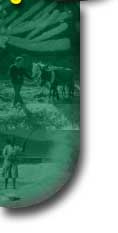Reducing Dengue Disease
Using Biological Agents
For "Kids of All Ages," especially those above 5th Grade
Click here to jump to a version for younger
kids.
What's it all about?
Dengue is an infection that is carried by mosquitoes and can cause severe
disease in people. It can cause headaches, pain, and rash, and, in more
severe forms, can cause internal bleeding and death. Currently, there
is no vaccine for dengue, and the most widely used methods of control
are chemical agents. These insecticides sometimes can harm the environment
as well as people. For this reason, scientists are looking for better
ways to prevent the spread of dengue.
Various living things, also known as biological control agents, can be
used to prevent infections carried by mosquitoes in place of chemicals
that may hurt the environment.
What's the problem?
People seek long-term and environmentally friendly relief from dengue
outbreaks.
Dengue is a disease that occurs in the tropics, in cities as well as
in villages. A few people have been infected who live in southern Texas
in the United States.
The disease is called "breakbone fever" because of the pain
that may occur in a personís joints. The internal bleeding that sometimes
follows repeated infection can be fatal.
Programs made to prevent dengue by trying to kill the adult stage of
the mosquitoes that carry this infection frequently fail because the adult
stage of Aedes
aegypti, the main kind of mosquito that carries dengue,
stays in villages and towns where they are difficult to find and kill.
Old tires and trash are places where these mosquitoes reproduce. Also,
the containers of drinking water, another place where these mosquitoes
live, must not be contaminated with potentially harmful chemicals.
What can be done?
For these reasons, people seek to use biological control agents that
can get into hard to find places, will not hurt people, and do not cost
too much.
"Biological control" means that people use different kinds of living
things, called organisms, and other biological products, many of which
can spread by themselves or are not harmful to the environment. This information
is here to explain the best ways to use this kind of intervention to keep
people from getting dengue.
Ways to control dengue
by controlling mosquito populations
ANTIADULT AGENTS (Agents that would kill the adult mosquito)
A biological
agent that would most effectively reduce risk of dengue would act
against the adult mosquitoes. Some chemicals that have been used in houses
destroy other predatory
arthropods
such as spiders and ants. The mosquitoes, then, lose their enemies, and
can reproduce and live. The spraying of chemicals might therefore ultimately
increase the transmission of dengue. Needed are agents that act directly
on the length of life, the feeding patterns, and the ability of an adult
to spread the disease.
Zooprophylactic
agents are animals that might slow the spread of dengue by attracting
mosquitoes that might otherwise feed on people. For example, some scientists
found that a different type of mosquito in Hawaii frequently feeds on
cats and remarked that the presence of cats would slow down dengue transmission.
This early finding showed that a large range of different animals and
plants, biological diversity, might protect people against dengue infection.
The idea needs further testing.
ANTILARVAL AGENTS (Agents that would kill the mosquito in the larva stage)
Aside from destroying the larval stages of A. aegypti, the ultimate
objective of a public health program using this type of agent is to reduce
the number of the adults of this vector
mosquito. However, a smaller number of larvae
do not always reduce the number of adults (Agudelo-Silva and Spielman
1984; Washburn et al. 1990). Destruction of a portion of the larvae in
a site may increase risk of human disease because sometimes the death
of some of the mosquitoes makes the other mosquitoes stronger.
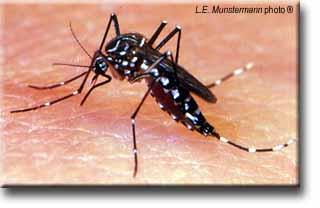
Aedes aegypti (female),
primary vector of dengue-hemorrhagic fever
around the world.
FISH
Chinese health authorities have used various kinds of fish to exclude
A. aegypti mosquitoes from breeding in large cisterns or other
containers of drinking water (Lu 1989). "..Small fishes, such as Claris
fuscus, Tilapia nilotica, and Macropodus spp., have...been
used in many regions to eliminate the larvae in the domestic water containers
with considerable success." The use of catfish appears to be particularly
effective (Neng et al. 1987). Such fish may have potential elsewhere in
the world where the introduction can be maintained and where the human
population does not object to the presence of these animals.
TADPOLES
Omnivorous
tadpoles constitute another potentially beneficial predator of
mosquitoes (Spielman and Sullivan 1974). The larvae of the giant Cuban
tree frog (Hyla septentrionalis) destroy aquatic
insects and algae growing in water containers. They rarely are found in
containers that hold less than several liters of water and seem to have
a small impact on Aedes mosquitoes. These frogs may somewhat slow
down the force of transmission of dengue. Of course any introductions
of an organism beyond its natural range must be done with the utmost reluctance
and caution.
OTHER MOSQUITOES: PREDATION
Various larval mosquitoes are adapted as predators of other mosquitoes,
including certain
Psorophora and Culex (Fuscus) species.
Toxorhynchites, a kind of mosquito with cannibal larvae, have attracted
much attention as biological control agents. Certain kinds of toxorhynchites
mosquitoes are good for control of A. aegypti because they breed
in the same kinds of containers.
There are problems with the use of toxorhynchites mosquitoes for control
of dengue. The technique began to lose luster when it was recognized that
it increased prey density. This type of interference effect became evident
when the prey was present in excess (Hubbard et al. 1988). Certain tests
and trials have shown this to be true.
Other predatory insects have been used to reduce the abundance of A.
aegypti mosquitoes. Dragonfly larvae, in particular, may be useful
for this purpose (Sebastian et al. 1990). In an experiment in Myanmar
(=Burma), target A. aegypti larvae virtually disappeared immediately
after 2 dragonflies were placed in each container, and the density of
target adults declined about 6 weeks later. The experiment is considered
as a success. These observations suggest that a predator that is satisfactory
for use in tanks of potable water must be large enough to consume many
larvae in a short time, cling to the sides of the container so that it
will not be lost when water is removed, develop slowly enough that it
need not be replaced frequently and be able to survive for months when
no larval mosquitoes are available as food. This model dragonfly release
effort may be too expensive to serve as a basis for operational anti-dengue
programs, particularly where our "throw-away society" provides alternative
breeding sites that may be too small, numerous and difficult to identify.
OTHER MOSQUITOES: DISPLACEMENT
Certain mosquitoes, most notably A. albopictus, appear to establish
relationships with A. aegypti that eliminate A. aegypti from parts
of their range (Gilotra et al. 1967). Indeed, the former species has displaced
the latter from large portions of the southern United States, and only
within a few years (Rai 1991). A. albopictus is a highly competent
carrier of dengue as well as a variety of other viruses and is a pest
species.
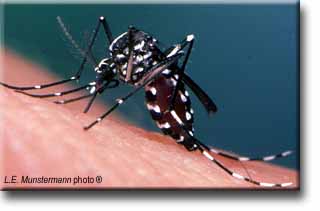
Aedes albopictus (female),
the Asian Tiger Mosquito,
a recent invader mosquito into North and South America,
Africa and Europe; a rural, secondary vector of dengue.
In Asia, A. albopictus and A. aegypti rarely are found
in the same sites. On Taiwan, for example, A. albopictus is found
in the dengue-free north and A. aegypti in the south, where dengue
is endemic (JC Lien, personal communication). The area of overlap there
is exceptionally small. In India, A. aegypti seems to displace
A. albopictus in urban sites, while the reverse occurs in rural
sites (Gilotra et al, 1967).
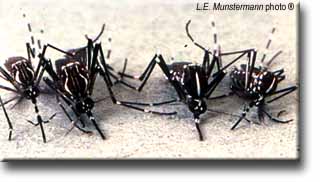
Frontal poses of male and female each
of Aedes aegypti (left) and Aedes albopictus (right)
A. aegypti is similarly related to another mosquito that breeds
in small containers, A. bahamensis (Spielman and Feinsod
1978).
Has the invasion of these exotic mosquitoes partially freed Florida and
certain other portions of the southern United States from the threat of
epidemic dengue? A. bahamensis is not a good carrier a variety
of viruses (Llewellyn et al. 1970). Indeed, although these mosquitoes
are capable of feeding on vertebrate hosts, they rarely do so and appear
never to do so before laying their first eggs (O'Meara et al. 1992b).
A. albopictus, on the other hand is a highly competent host for
dengue and is a pest.
Sexual interaction may provide another mode of displacement. In the event
that the males of one kind of mosquito were to mate with, but not effectively
fertilize, the females of another, the fertility of those females might
be impaired (Spielman and Kitzmiller 1967). Then, the population would
be unable to continue to produce more mosquitoes.
OTHER MOSQUITOES: GENETICALLY MODIFIED STRAINS
A discussion of "vector control" should also mention the potential of
genetics for use against mosquito-borne infection (Curtis 1990).
The development of methods to modify genes of mosquitoes is frequently
believed to provide the best hope for intervening against malaria and
dengue. The present efforts to genetically control mosquitoes are based
on the techniques of molecular genetics. The main objective is to modify
a laboratory strain of mosquitoes in order to reduce its ability to serve
as a carrier of disease and eventually to release these mosquitoes in
nature such that the wild mosquitoes will eventually be replaced. However,
there are several problems with this approach, and prospects for this
technology seem dim.
OTHER INSECTS: HORMONOMIMETIC COMPOUNDS
A "third generation of insecticides" was designed in a classical program
of work originally housed in the late Carroll Williams laboratory
at Harvard University. Williams anticipated that active hormonomimetic
compounds could be designed that would block development of particular
kinds of insects (Williams 1967). The first such hormonomimetic insecticide
was later modified to produce a more active and stable compound that is
commercially available under the name methoprene or altocid (Staal 1975).
Methoprene now promises to be the most environmentally acceptable chemical
usable against mosquitoes and could possibly be used in drinking water.
CYCLOPOIDS
The ability of certain cyclopoid copepods
to destroy larval mosquitoes was noted in 1938 (Hurlbut). These "water
fleas" were seen preying on newly hatched larvae. Field experiments in
Rongaroa (French Polynesia) later demonstrated that
Mesocyclops can be used in interventions against A. aegypti
(Riviere et al. 1987). Cyclopoid copepods appear to limit the abundance
of certain kinds of mosquitoes. However, not all copepods destroy all
mosquitoes.
Field trials have been conducted to determine whether copepods can usefully
destroy larval Stegomyia mosquitoes. Copepods (Macrocyclops albidus)
were released into each of about 200 tires arranged in 2 stacks of about
100 discarded tires each located near New Orleans (Marten 1990a). A third
stack remained untreated. Larval A. albopictus that were numerous
in the treated tires at the beginning of the experiment virtually disappeared
within 2 months. Adults disappeared about 1 month later and remained scarce
for at least another year. These predators, however, did not reduce the
abundance of Culex salinarius, another type of mosquito.
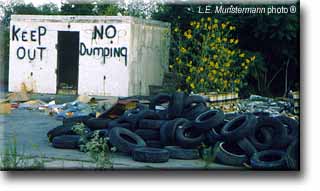
Discarded tires, a common urban habitat
of Aedes aegypti and Aedes albopictus
A series of other field trials are currently being conducted in different
parts of the world to determine if this is a good way to prevent transmission
of disease. Preliminary results have been encouraging. Cyclopoids now
appear to offer high promise as biological control agents for A. aegypti
mosquitoes. The technology is "appropriate" and costs appear to be modest.
Little environmental risk is evident. However, certain drawbacks of a
copepod release program have been identified. Although highly promising,
the practicality of these biological agents in anti-dengue programs remains
to be established.
PROTOZOA
Parasites provide fascinating prospects for the destruction of
mosquitoes. Although parasites do not affect all kinds of mosquitoes,
in some, as the larvae eat these parasites, they can cause death (Walker
et al. 1987).
MICROSPORIDIA
Until recently, the microsporidian
pathogens of mosquitoes appeared to hold little promise for use against
A. aegypti mosquitoes because they did not appear to live well in similar
habitats. Recent findings, though, show that this might be a possibility
(Sweeney and Becnel, 1991). For a biocontrol effort against A. aegypti,
microsporidian-infected eggs might be placed into natural breeding sites.
Although many of the mosquitoes would escape the lethal effects of this
agent, the infection should cause problems for those mosquitoes that escape.
BACTERIA
BTI is a proven, environmentally safe mosquito larvicide that is nontoxic
for people. Bacillus thuringiensis israelensis (BTI) was discovered
only in the 1970's (Goldberg and Margalit 1977). It has become commercially
available under such names as Teknar, Vectobac and Bactimos. The beauty
of this material is that an application destroys larval mosquitoes but
spares any predators that may be present. The toxin, however, is destroyed
by sunlight. This imposes a necessity for frequent application. Weekly
visits to each breeding site may be required, thereby making it more expensive.
FUNGI
Of the numerous fungi that have been described, only Lagenidium
giganteum seems to have the ability to possibly stop the spread
of disease transmission through mosquitoes. Indeed, the federal Environmental
Protection Agency registered several such formulations for use against
larval mosquitoes on 16 August 1991. Oospores
that can resist droughts can readily be produced in bulk (Kerwin et al.
1986). Oospores survive for many years in soil, but reactivate only about
a month after flooding. In practice, the spores are activated by staying
in water for 1-2 weeks before being sprayed onto the surface of the site
to be treated. About half of the target mosquito population becomes infected
by the oospores and larvae continue to die for the next several weeks.
The infection may continue for a period of time. This material holds promise
for use against dengue vectors breeding in potable (drinking) water; it
should soon become commercially available.
Although these preparations seem to persist for a long time in water,
there are certain additional problems. It can be difficult and costly
to apply. The fungus infects and kills only a part of target larval mosquitoes,
as well. The level may not be large enough to decrease risk of human dengue
infection.
Various other species have been considered for use against mosquitoes,
but there have been problems with these also (Whistler et al. 1974, Chapman
1985, Lacey and Undeen 1986).
Other fungi, such as Leptolegnia chapmani (Zattau and McInnis
1987) and Toplocladium cylindrosporum (Ravellec and Riba 1989),
present some potential for anti-dengue programs.
PLANT EXTRACTS
The uses of various plant extracts to decrease the transmission of dengue
are very traditional (Williams 1967). Chrysanthemum flowers, the neem
tree, marigolds, Swartzia madagascariensis -- a variety of an African
plant, and the Ethiopian soap-berry vine all create elements that can
be used as insecticides (Spielman and Lemma 1973, Minjas and Sarda 1986,
Green et al. 1991). Local traditions provide guides to the identification
of such plants. Thus, many plants contain things that destroy mosquitoes;
they can be useful in village-level self-help anti-dengue programs where
there are a large number of people willing to help and where the plants
are cheap.
ALGAE
Certain algae seem to fill the guts of larval mosquitoes with a mass
of material that they are not able to digest, and this is said to hurt
growth (Marten 1986: 1987). The promise of such material against the mosquitoes
carrying the dengue virus, however, seems limited because these mosquitoes
usually breed in sites that are too dark for algae.
ATTRACTANTS
Louis Roth's classical 1948 study on the role of sound in A. aegypti
looking for mates created a highly productive series of research efforts
that focused on the possibility of gathering mosquitoes by attracting
them to a source of odor or sound. These efforts continue to this day
MISCELLANEOUS
A broad range of predators and parasites provide potential for developing
anti-dengue agents. Different types of worms and spiroplasms
could decrease the ability of mosquitoes to breed and carry dengue, as
well (Case and Washino 1979, Kerwin and Washino 1985).
COMMENTARY
This case study is another in a long line of reviews of the potential
of biological agents for decreasing transmission of one or another vector-borne
agent, and, like these others, concludes with a set of recommendations.
The major requirement of a program that will help to stop transmission
of dengue is the ability to get into obscure bodies of water scattered
within and around groups of humans where A. aegypti mainly breeds.
An untended guard-dog or a hidden automobile tire presents an obstacle
to any effort in a society that respects privacy. Only biological agents
carry the potential for overcoming this difficulty, and the most likely
agents are those represented by closely related organisms. Toward this
end, we require a program of biological research aiming toward an understanding
of the factors that limit the number of mosquitoes.
A second requirement for an anti-dengue program is the potential for
use in potable (drinking) water. Household sites for collecting and storing
potable water generally can be visited in a way that will permit an effort
to introduce biological agents. Biological agents can avoid the requirements
of toxicity and absence of odor that such an application requires. Toward
this end, we require a program of biological research aiming to develop
methods for formulating BTI such that the material will not rapidly sediment.
The most vulnerable point in the dengue transmission cycle lies in the
length of its incubation
period. Toward this end, we require an understanding of the factors
that influence the length of life of these vectors.
Nearly as sensitive in the continuation of dengue transmission is the
requirement for a vector-host relationship (a relationship between a mosquito
and the host where it feeds) that focuses on mammals that have the ability
to maintain the basic reproductive rate of the thing that causes the disease.
Toward this end, we require an understanding of the host-seeking behavior
of these mosquitoes.
The requirement for a long-term, sustainable effort makes cost an important
factor in any public health effort. For this reason, intervention agents
cannot generally be produced in living biological systems. Production
should be possible in certain tanks, and a minimum number of steps should
be required for preparation of the final formulation. Extended shelf-life
is crucial, as is the ability to kill all mosquitoes that have been treated.
Pesticide development efforts should aim toward these objectives.
Most critical in an approach toward suppressing or containing any vector-borne
infection is the ability to select research directions on the basis of
practical matters. Any anti-dengue campaign that is designed should pursue
attainable objectives that are worthwhile and sustainable. Failure to
satisfy any of these criteria may result in the worst public health harm,
an ultimate increase in the disease.
Activities and Puzzles
 Crossword
Puzzle - Reducing Dengue Disease. Crossword
Puzzle - Reducing Dengue Disease.
top of page | next
page
(references and credits)
|













